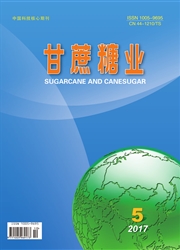

 中文摘要:
中文摘要:
本研究以30个甘蔗栽培种或原种为材料,用ISSR标记方法进行了遗传多态性分析。结果表明:供试30份甘蔗种质材料的遗传相似性系数在0.375~1.000之间,其中,甘蔗栽培种与热带种的遗传相似性系数在0.850~0.950之间,说明这些甘蔗栽培种与热带种的血缘关系近;甘蔗栽培种与割手密之间遗传相似性系数在0.525~0.675之间,说明这些甘蔗栽培种与割手密有一定的血缘关系;甘蔗栽培种与斑茅的遗传相似性系数为在0.375—0.525之间,表明这些甘蔗栽培品种与斑茅的血缘关系较远(实质上参试的甘蔗品种都不是斑茅的后代);参试的23份栽培种之间的遗传相似性系数关系在0.725~1.000之间,说明这些甘蔗栽培种之间的血缘关系较近,种质血缘窄,应加强含有多个野生种质的杂交后代的选育。同时,聚类分析结果表明,在遗传相似性系数为0.720水平上可将30份供试甘蔗种质材料分为3个类群,其中3个热带种和23个栽培种聚为一类,3个割手密聚为一类,斑茅单独聚为一类。
 英文摘要:
英文摘要:
ISSR molecular markers were applied to analyze the genetic polymorphism of 30 sugarcane clones. The results showed that the genetic similarity coefficient among the selected sugarcane germplasm materials were between 0.375-1.000. Those between sugarcane cultivars and Saccharum officinarum were 0.850-0.950, indicating close consanguinity. Those between sugarcane cultivars and Saccharum spontaneum L. were 0.525-0.675, indicating some consanguinity. Those between sugarcane cultivars and Saccharurn arundinaceum were 0.375-0.525, indicating remote consanguinity (as a matter of fact, all the cultivars used in the experiment is not the descendants of Saccharum arundinaceum). The genetic similarity coefficient among the 23 cultivars were 0.725-1.000, indicating close kinship and narrow genetic diversity, and therefore multiple wild germplasm should be introduced into cane hybrids in the future breeding. The cluster analysis on the level of genetic similarity coefficient of 0.720 classified the 30 sugarcane germplasm materials into 3 groups: Saccharum officinarum and cultivars, Saccharum spontaneum L., and Saccharum arundinaceum.
 同期刊论文项目
同期刊论文项目
 同项目期刊论文
同项目期刊论文
 Study of red mud improvement with the mixing method and the impact of Pennisetum hybridum plantation
Study of red mud improvement with the mixing method and the impact of Pennisetum hybridum plantation 期刊信息
期刊信息
